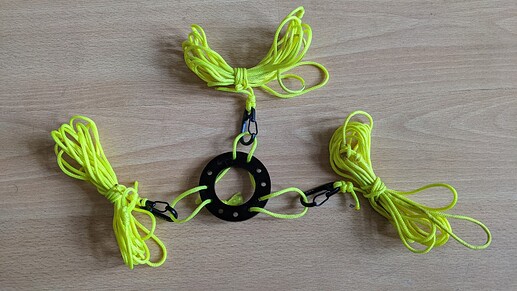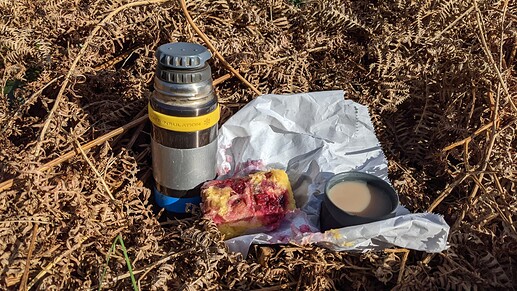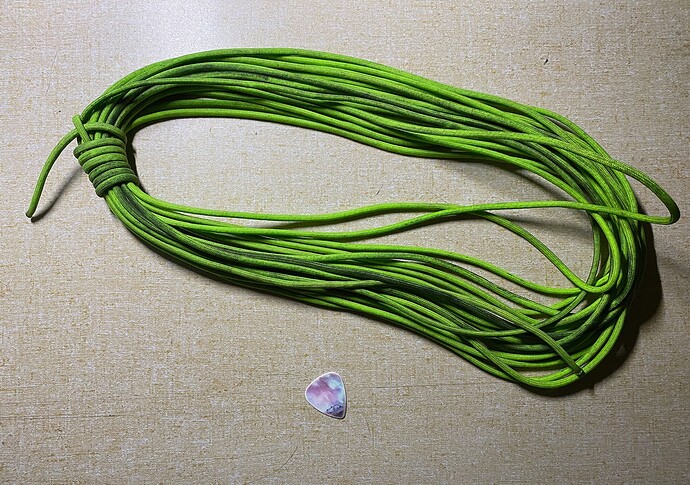That’s what I’m at with the KX2, a EFHW, and a pole. I have everything staged in my pack for a quick setup. I usually take a little longer to put it all away, but several times when I’ve gotten rushed due to incoming weather, I’ve got it all back in my pack in less than a minute. I just have to untangle stuff when I get back to the trailhead or at home.
Please do and post it in here. I’d love to see that.
Eric KG6MZS
I’d expect nothing less from the master. That is really radio on the run Fred. It explains how you have been able to do so much.
Cheers, Eric
Great video Eric -
I pretty minimal - so about 10 minutes. Most of it is getting my line thrown in a tree the way I like it. But IMHO 30 min isn’t too long at all if you enjoy the process!
73 - Chris
Thanks Chris,
Best advice I was ever given about SOTA was to activate in a manner that best suits you. I like to see how far I can be heard and to make as many contacts as I can, so I like to set up more than a minimal antenna and bring along come comfort items like a table and chair. That’s usually my thing.
I usually activate solo because with most people, I can feel the meter running. Most people don’t like to get started as early in the morning as I do or stay as long.
73 Eric KG6MZS
lol Eric! I took my wife and kids with me on a SOTA summit on a Joshua Tree Vacation in February. After 20 minutes on top my wifey was a little unnerved by the hike and height and started down. I couldn’t get a spot out, so took me nearly an hour to get 4 in the log. I RAN down the mountain lol. Made it down in 20 minutes and ended up only being 10 minutes behind them. But likely not bring them on a SOTA again.
I do enjoy long activations. Living in Ohio, I’m surrounded by 2 pointers. So I travel to areas with 8 and 10 pointers. I feel like I have to get in as many sites as possible on those long trips. Being rushed makes it a little less fun… but I can’t take forever to make MG either!
I’m usuall right at 15 minutes. I usually use one of two aerials – either the 1/4 wave vertical for 20m, or the 30m dipole. I force each onto other bands, with the help of the KX2 tuner. I don’t like to go below 7MHz on the vertical, and once in awhile I’ll push the dipole to 3.5 MHz. Either aerial has snagged SOTA DX, so they each work well.
30m dipole is a little quicker to set up, but not so much that I prefer one over the other for set up time.
73, Jim KK0U
Fun video, I average 10-15 minutes.
My 40m thru 6M all band link dipole goes up in a few minutes…never more than 5 minutes, 12 ft off the ground (highest point).
No guy ropes needed as the shorter mast slides over the handle of a 12 inch screwdriver pushed into the ground, and the mast is then tied to a short bush/log/rock or something it is next to. Have used my backpack a few times for this also.
If I’m on a bare summit, and it’s not windy, I don’t even need the base bush/rock/log.
The dipole has 20 ft of poly rope permanently attached to each end of the dipole used to tied off to a rock, tree, bush etc.
Easy Peasy and very fast to put up. I have worked over 40 DXCC countries form summits with it, so the 12 ft apex apparently isn’t much of a problem.
Tears down just as fast…and off to that 5th summit of the day…
73
Pete
WA7JTM
I now use small clips to allow guys to be unclipped when (not if) they become tangled.
My normal set-up for HF is a SOTAbeams linked dipole which makes for a very quick set-up. The winders, whilst simple, are a real time saver significantly reducing the number of tangles. I have used two colours of wire for each element to speed up untangling should it happen. I will use different colurs for each linked element next time.
None of the above set-up times have included tea and cake.
Kevin,
Oh no, those guys are waaaaay too clean to have actually ever been used:
Can you tell I have been activating in the recently reopened Bobcat Fire burn area?
Seriously though, very trick kit you have there. …and the guy ring in okay too. ![]()
73 Eric KG6MZS
If I’m using the EFHW, 10 minutes.
If it’s the minimal setup with an AX-2 on a tripod, about 5 minutes.
I used the latter this past weekend with the threat of rain. I had 12 Qs when the rain started. I was packed up in 3 minutes and sorted everything out back at home. Had I been using the EFHW, not sure I would have had enough time to reach my quota for a POTA activation as well, and would have gotten much wetter. 
For me the only issue to deploy the set-up fast is the strong wind.
If your summits are wide and flat an inverted-V dipole such as the SOTABeams Band Hopper IV or Band Hopper III are very quick. Like @MM0FMF has pointed out practice means that 9 times out of 10, as long as there isn’t anyone looking on (kiss off death in this case - double or triple setup time), it will go up with no adjustment required, and that is about as good as it gets - resonant antenna, self-supporting, no guying required. On a good day it is 5 mins from arrival to being on HF.
I’ve tried end-fed antennas, I dare say I would get better at guying with more practice, but it just seems to involve more faff to me. Having the correct winders makes a massive difference however.
Mark.
Practice makes perfect. Though setting up my 80m fullsize dipole takes an age mainly because it feels like you are walking from Land’s End to John O’Groats when walking from one end to the other!
The other trick is making sure you always put the gear away the same, wind up the antenna a certain way, put everything back in its correct bag, put the bags in the bag the same place in the rucksack. Everything in its place and a place for everything so you just know where everything is. That’s important for checking you have the gear you need before leaving home/car. When on holiday expeditions using different gear and a different bag it does take longer to set up.
I managed to rig a 10 vertical on a 5 m pole, a 15 m delta loop on a 7 m pole, an inverted V EFHW on a 6 m pole, all guyed, and finally a 2 m slim-g on a 4 m pole, strapped to a fence. Time taken 20 mins.
Absolutely essential. On the one occasion I didn’t do this because it was getting cold, dark and snowing, I had an absolute nightmare of a job untangling feeder, antenna wire and guys when I got home.
Putting everything back where it belongs is also a really simple way of making sure you haven’t left anything behind, eg pegs or a 49:1.
My quickest set up for HF remains the Carbon 6 pole shoved into a gap in a pile of rocks or the centre hole of a trig and a 41’ wire strung over (inverted V) with a 17’ counterpoise on the ground. Direct connection to the radio via 9:1 un-un. Tuner needed as this is a random wire. I can be up and running in under 5 minutes.
As a regular winter activator in my 70’s now with poor circulation I’m as keen as anyone to minimize my set-up and pack-away times so I read this kind of topic with keen interest to improve the way I’m doing it. But the danger is with this kind of question, readers might think the respondent with the quickest time has the best solution.
If I have to set up a tarp in high wind and/or rain (as I’ve had to do in recent weeks) that time can dwarf the antenna set up time especially if I have to forage for rocks to weigh down the sides of the tarp [pegs don’t penetrate deep on the thin soil over rocks on most of my SOTA summits].
As mentioned on another thread, I don’t rush to wind and unwind the feeder and dipole wire legs on my quad-band and tri-band linked dipoles as I believe careful handling accounts for their low maintenance. By contrast, I don’t need to handle my Chameleon MPAS Lite HF vertical so delicately due to its robust construction.
In order of short to long set-up times, my antennas are:
- 2m/70cm Diamond RH770 ½-wave telescopic whip [I rarely use the HT’s stock ‘rubber duck’ antenna]
- 2m J-pole on 5m glass-fibre pole
- 6m flowerpot on 5m glass-fibre pole
- Chameleon MPAS Lite HF vertical
- 40/30/20 or 40/20/10 EFHW on 3m or 5m glass-fibre pole
- 60/40/30/20 linked dipole on 5m glass-fibre pole
- 80/60/40 linked dipole on 5m glass-fibre pole
- 2m Yagi or 70cm Yagi on 3m pole
All the poles are guyed.
Sod’s Law states all set-up / pack-away times are much longer on rocky summits in adverse weather than the times you measured in your back garden
Great video Eric!
I think I have the same chair you do. I’m curious about the table you are using. I have been thinking to get something like that. Do you happen to know the brand and/or where you bought it? Thanks!
Thanks Bill!
The table is made by a company called Trekology and it is very light. I was a bit concerned about the build - it seemed like it wasn’t very robust, but it has survived well over 100 activations now. The shock cord is a little tired and the stuff sack is ripped at the mouth, but it still works just fine:
HTH
73 Eric KG6MZS
This is the exact setup I’ve been using lately. I like my linked dipole, but fiddling with the links is a bother in deep snow / subfreezing condx. One advantage to snow: erecting the pole is easy (plunge it into the snow) and I can put it almost anywhere I choose!


